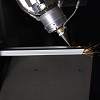The Competition Between Fuel and Electric Vehicles and the Technological Innovations in Tube Bending
Introduction
The global automotive industry is undergoing a massive transformation, driven by environmental regulations, consumer demands for safety, and the growth of EV technology. These trends push manufacturing towards "lightweighting, high performance, and high safety." Lightweighting is crucial for fuel efficiency and EV range. Modern cars increasingly use high-tensile steel, aluminum, and magnesium alloys. The rise of EVs has significantly boosted aluminum demand.
Metal tubing is vital in automotive manufacturing, impacting vehicle performance and safety. Tube benders are crucial for precisely shaping these tubes, enabling more complex, lighter, and higher-performing components. The tube bending industry's focus on quality and precision profoundly impacts achieving lightweighting, high performance, and high safety. Even minor flaws can compromise system integrity. For example, maintaining a "thinning rate" below 15% in exhaust pipe bending is critical. Thus, tube benders are indispensable to automotive innovation.
This article explores the role of tube benders in the automotive industry, examining component needs, material and precision challenges, how benders address these, and how smart manufacturing technologies (IoT, Digital Twin, AI) are upgrading production. It also forecasts future trends in tube bending with the rise of EVs.
What Metal Tube Components Can Tube Benders Produce in the Automotive Industry?
Automobiles contain thousands of bent metal tubes vital for structure, powertrain, cooling, and safety. Demands for bending precision and material properties are rising due to complex designs and lightweighting.
Key Applications:
- Car Body and Chassis Structural Parts: Seat frames, anti-collision structures, and dashboard crossbeams require high-precision bending for lightweighting and safety. Dual-direction benders are common for complex shapes.
- Powertrain and Exhaust Systems: Exhaust pipes need precise bending and smooth bends to optimize engine performance.
- Cooling and Air Conditioning Systems: EV battery cooling tubes and HVAC tubing demand complex layouts and precise bends for efficient thermal management.
- Other Applications: Sunroof frames require high-precision bending for smooth operation.
Maintaining internal integrity is crucial; deformation or uneven wall thickness can compromise performance. Choosing the right tube bender and molds is vital for precision and quality.
Technical Requirements and Challenges in Automotive Tube Production
Automotive tube production demands extreme geometric precision and long-term stability. Challenges include material properties, bending complexity, and defect control.
Challenges:
- Material Properties: Aluminum, spring steel, and high-tensile steel are prone to "springback," "wrinkling," and "cracking." Magnesium alloys are difficult to process, requiring heated bending. Carbon fiber composites have distinct forming processes.
- Bending Complexity & Precision: Modern tubes require complex geometries, demanding multi-axis and dual-direction benders with extremely high precision (±0.05°/mm).
- Common Defects: Ovality, wall thinning, wrinkling, cracking, and springback are common. Solutions include mandrels, fillers, and local heating.
How Tube Bending Technology Meets Automotive Industry Demands
Tube bending technology evolves with smart manufacturing integration to meet automotive demands for precision, complexity, efficiency, and lightweighting.
Bending Machine Advantages:
- All-Electric Tube Bender: High precision (±0.05°), high efficiency, energy-saving (40-60% electricity), clean, low-noise. Core of smart manufacturing.
- Dual-Direction Tube Bender: Unique advantage for complex, multi-bend tubes.
- Hybrid/Hydraulic Benders: Balance cost and power for specific applications.
Smart Manufacturing Integration:
New-generation benders integrate smart elements for proactive optimization:
- Industrial IoT (IIoT) & Automated Scheduling: Seamlessly connects benders to MES/ERP systems for remote commands and data feedback.
- Cyber-Physical Systems (CPS) & Digital Twin: Allows pre-production simulation and optimization, reducing trial costs.
- Sensors and Data Analytics: Real-time quality monitoring and automatic error compensation.
- Artificial Intelligence (AI) Learning & Predictive Maintenance: AI analyzes data for automatic compensation, self-learning adjustments, and predictive maintenance, boosting efficiency and yield.
Future Trends: Electric Vehicles and Smart Bending Technology
EVs bring dual challenges: lightweight structures and cooling systems, demanding tube bender upgrades. EVs' stricter demands for range and weight necessitate benders capable of handling high-strength, hard-to-form materials with higher precision. Complex EV battery and motor cooling systems require precise, compact tube layouts. New materials like thermoplastic hoses are emerging, requiring smarter benders integrated with 3D simulation and auto-feeding.
Future bending technology is a key part of smart manufacturing systems, with AI and Digital Twin at its core. AI enables benders to "learn by themselves" and "compensate automatically," optimizing settings and enabling predictive maintenance. Digital Twin creates virtual machine versions for pre-production simulation, saving time and material. Sensors and Big Data Analytics provide real-time correction and continuous process optimization.
Conclusion
Tube bending in the automotive industry has evolved to a highly precise and intelligent manufacturing process. The pursuit of lightweighting, high performance, and high safety, especially with EVs, presents both challenges and opportunities. All-electric and dual-direction benders, combined with smart manufacturing elements (IIoT, Digital Twin, AI, sensors/big data), are revolutionizing production. AI learning and predictive maintenance will enable self-optimizing benders for more efficient, reliable, and flexible production. Data analysis will drive continuous advancement. The strategic integration of tube benders with smart manufacturing is crucial for automotive manufacturers to gain a competitive edge.





